Climate change and coronavirus: Five charts about the biggest carbon crash
- Published
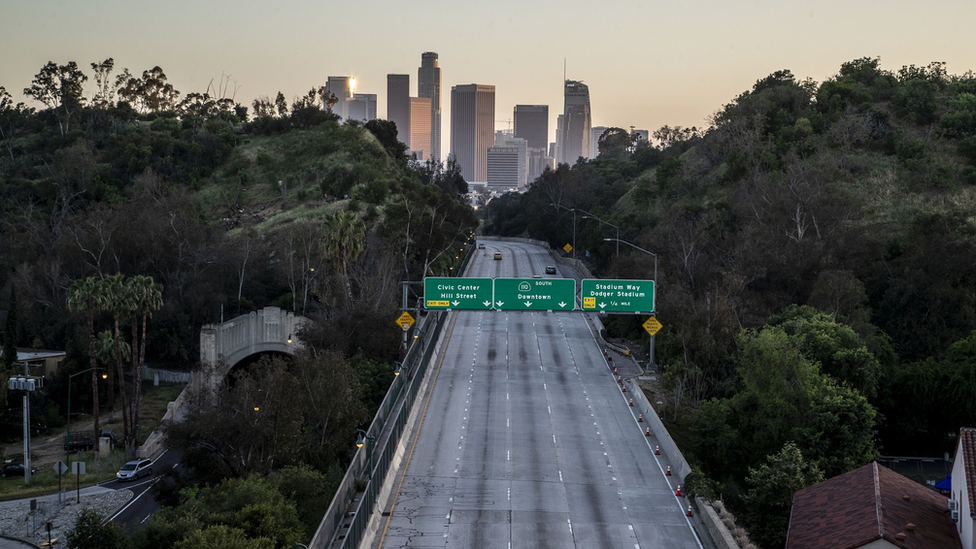
Traffic has almost disappeared in many cities around the world, such as LA (pictured)
We're living through the biggest carbon crash ever recorded.
No war, no recession, no previous pandemic has had such a dramatic impact on emissions of CO2 over the past century as Covid-19 has in a few short months.
Multiple sources indicate we are now living through an unrivalled drop in carbon output.
But even though we will see a massive fall this year, the concentrations of CO2 that are in the atmosphere and warming our planet won't stabilise until the world reaches net-zero.
As our chart shows, since the Spanish flu killed millions over 100 years ago, the global expansion of emissions of CO2, from the use of oil, gas and coal has risen massively.
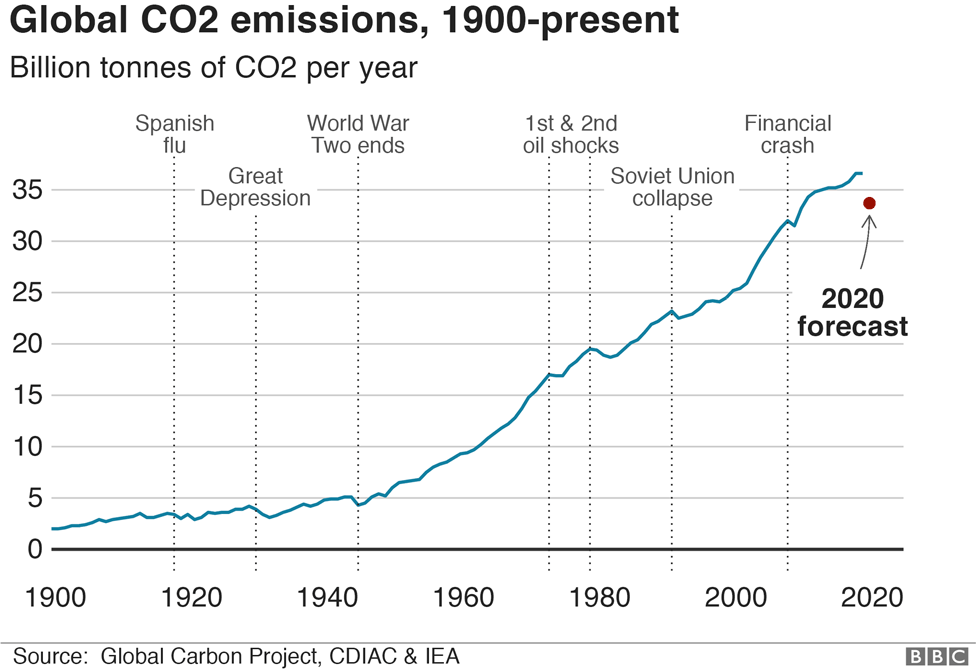

While these energy sources have transformed the world, the carbon seeping into our atmosphere has driven up global temperatures by just over 1C since the mid-1850s.
They could rise by 3-4C by the end of this century if CO2 levels aren't savagely reduced.
Over the past 100 years, as indicated on the graphic, a number of events have shown that dramatic falls in carbon are possible.
Much is made of the financial crash in 2008-2009, but in reality, carbon emissions only fell by around 450 million tonnes between 2008 and 2009.
This is much smaller than the fall in CO2 in the aftermath of World War II, which saw a drop of around 800 million tonnes.
Coronavirus and climate change a "double crisis", say activists
It is also smaller than the global recession in the early 1980s that followed the oil crisis of the late 1970s.
During this period, CO2 went down by around one billion tonnes.
But the coronavirus pandemic of 2020 dwarves all of these previous shocks by some distance.
In a few months, demand for energy globally has fallen off a cliff.
The International Energy Agency (IEA) says that the world will use 6% less this year, external - equivalent to losing the entire energy demand of India.
This will feed through to large falls in CO2.

A number of different analyses, including this one from Carbon Brief, external, show that emissions this year will fall by 4-8%, somewhere between 2 and 3 billion tonnes of the warming gas.
That's between six and ten times larger than during the last global recession.
We're travelling less
By air and on roads, the world has cut back heavily on travel.
Full lockdowns have also pushed global electricity demand down by 20% or more, says the IEA.
Across the full year, the need for electricity will fall by 5% - the biggest drop since the Great Depression of the 1930s.
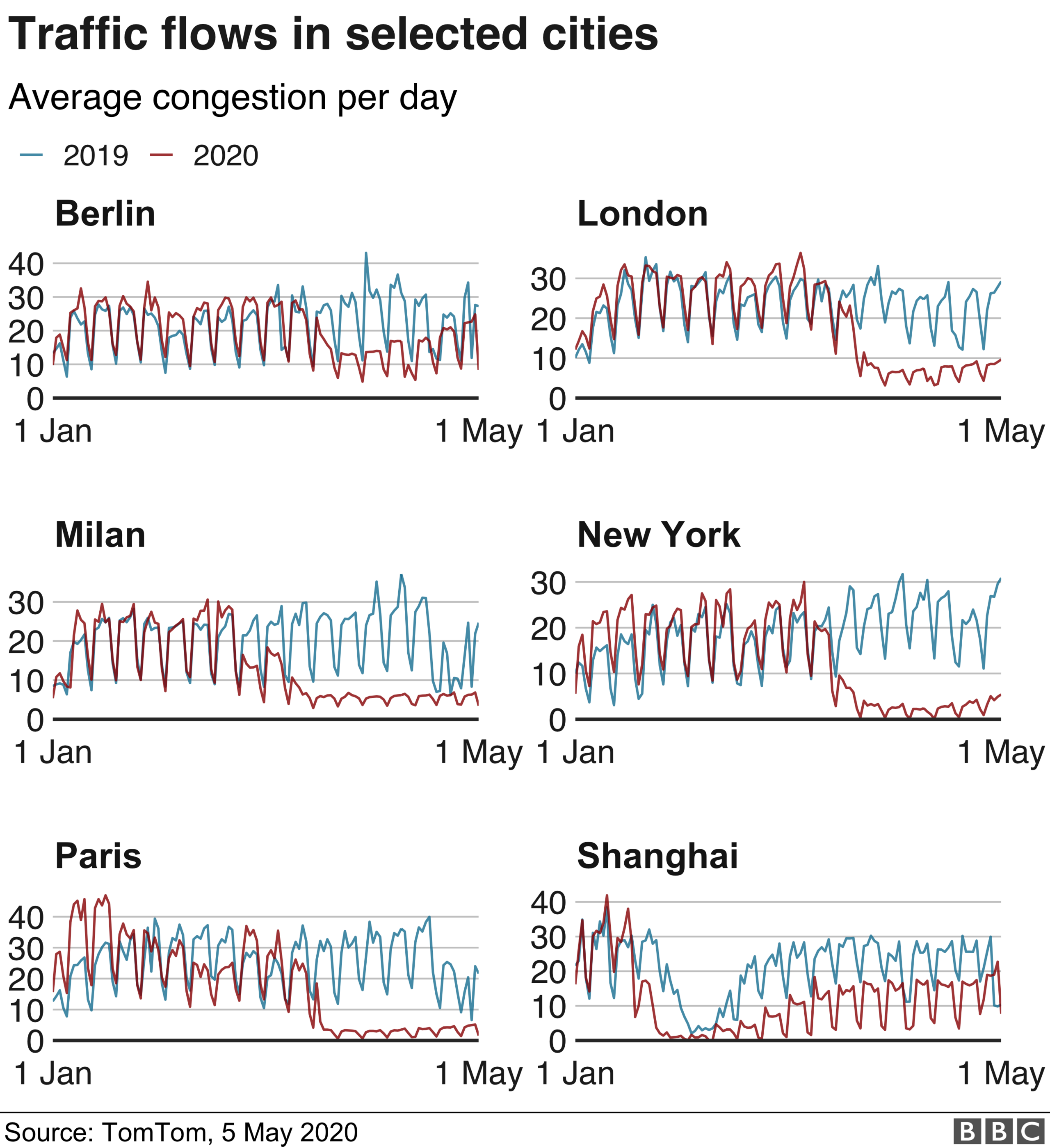

"This is an historic shock to the entire energy world," says Dr Fatih Birol, IEA executive director.
The changes in energy demand will have a knock-on effect on global coal demand, which is set to fall 8% this year.
With China the first country to stall its economy in response to the virus, coal use dropped sharply at first, though it is now rebounding and the expectation among energy analysts is that production this year will be down by just over 1%.
Researchers say the biggest thing hitting CO2 emissions right now is the reduction in road transport.
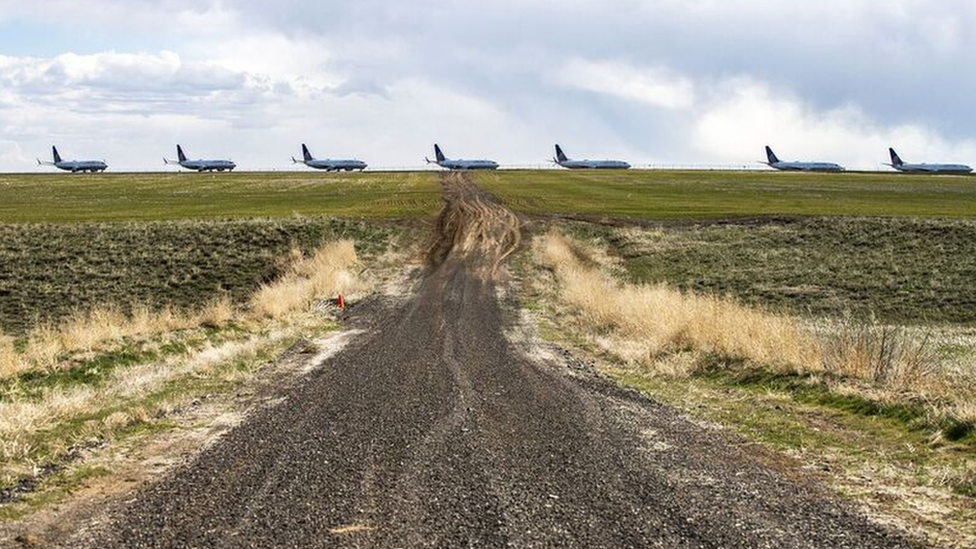
Air travel has fallen by half in the US
According to the IEA global average road transport activity fell to 50% of the 2019 level by the end of March 2020.
As can be seen in our chart, almost every country has seen a huge drop in road use. This has resulted in a massive fall in the use of oil.
"Back in the 2009 recession, average oil demand dropped by 1.3 million barrels per day versus 2008. And now 2020 is set to average 10 million barrels per day less than 2019." said Erik Holm Reiso, from Rystad Energy, an independent research firm.
"It's a much more severe cycle."
Similarly, air travel has dropped hugely, but by different amounts in different regions.
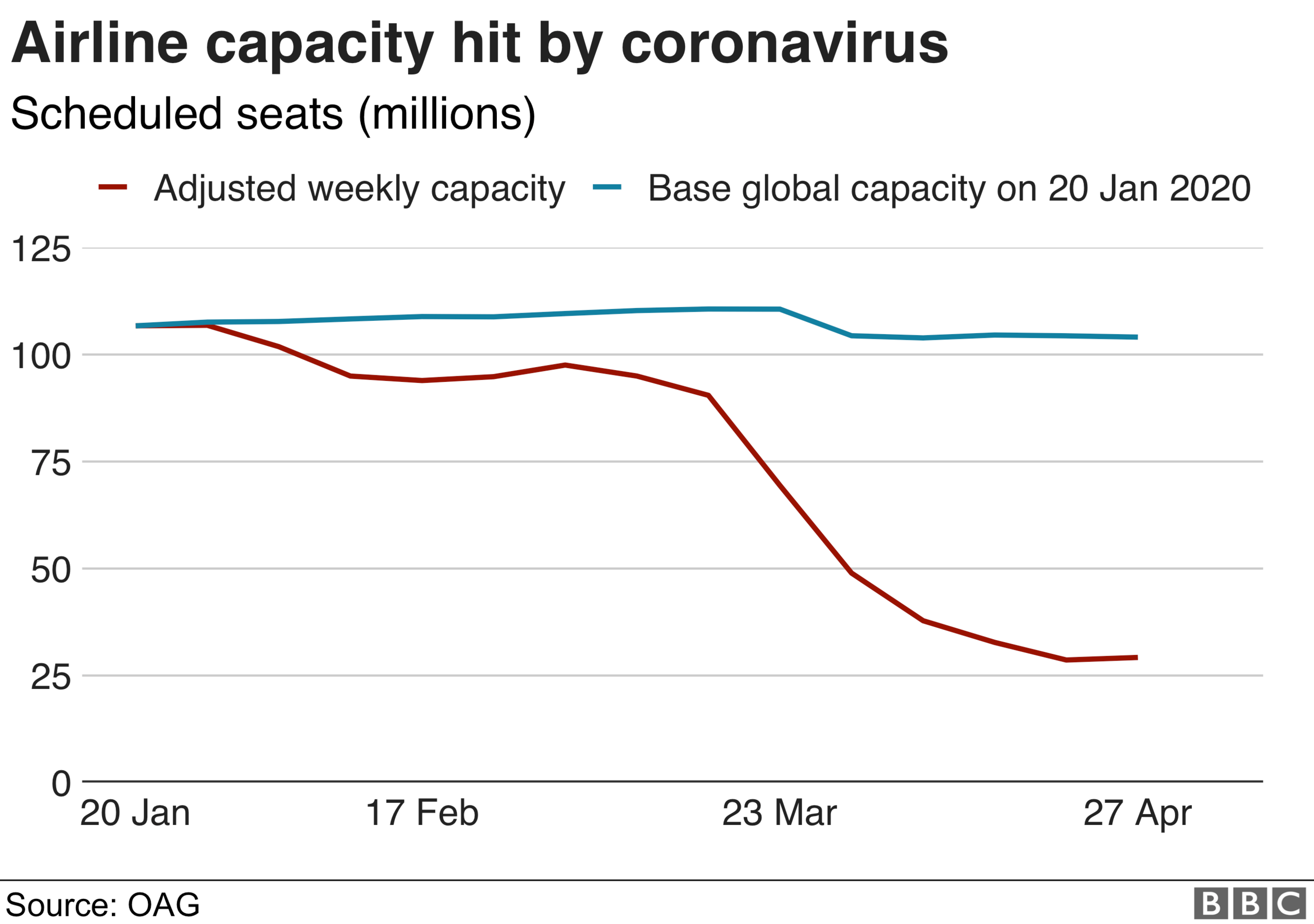

In Europe, the number of flights is down around 90%, whereas in the US it has been more resilient with around half the number of planes taking off compared to last year.
Globally, though, the demand for jet fuel is down 65% year-on-year to April.
"What we're seeing is that the largest relative reduction is in air traffic," said Robbie Andrew, a senior researcher at the Centre for International Climate and Environmental Research (Cicero).
"But air emissions are only about 3% of global total. So while the relative reductions in land transport are lower than air transport, the absolute reductions there are much more significant."
It's not the same everywhere
While the lockdown might feel rather uniform across the world, there have been huge variations in emissions reductions from different cities.
If we take Paris and New York as examples, the contrast, as shown on our chart, is huge.
Paris saw a CO2 drop of 72% (+/-15%) in the month of March compared to normal.
New York in the same period, saw a CO2 fall of around 10%.
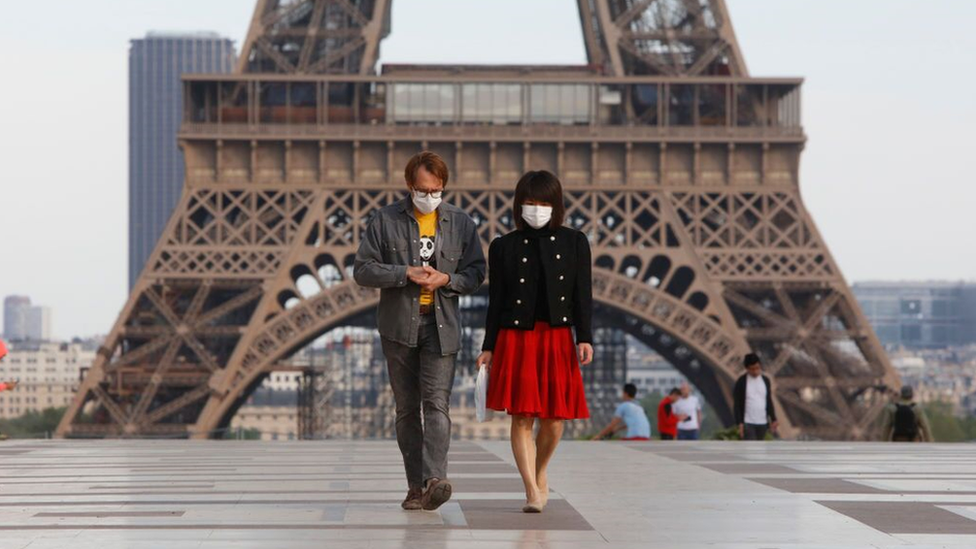
Paris has seen a dramatic fall in CO2 since the lockdown began
So why the big difference?
"In the Paris area, there are no large fossil fuel power plants, or industrial sites," said Philippe Ciais, from the Institut Pierre Simon Laplace in Paris.
"Another difference is whether buildings are heated with fuels or with electricity. In France, around 70% of electricity comes from nuclear."
Much of New York's CO2 comes from emissions related to the heating of buildings. But significant emissions come from fossil fuel plants based within the city limits. Cars make up a much smaller proportion of overall energy use.


"I guess something to think about is that we shut down the entire city and got a reduction of 10% in the CO2 emissions," said Prof Róisín Commane from Columbia University in New York.
"We are still emitting more than 80% of our previous CO2 emissions. That is a massive number. So personal behaviour really isn't going to fix the carbon emission problem. We need a systematic change in how energy is generated and transmitted."
What is climate change?
Have CO2 emissions already peaked?
Back in 2008, the European electricity industry was hit badly by the global financial recession and demand for power fell sharply.
But when that demand picked up again, it was solar and wind that were by then large enough to supply all the growth.
Europe's use of fossil fuels to produce electricity never returned to the level it had been at before the crash.
Experts now believe something similar could happen with the coronavirus pandemic.
"In about half of the world, we've already seen peak demand for fossil fuels," said Kingsmill Bond, from independent financial think tank Carbon Tracker.

Air pollution has cleared in some parts of Nepal due to restrictions there
"In Europe it was 2005, in the USA 2007."
This means that the trend in demand has been downhill ever since.
He added: "There has been a global coal demand peak in 2013. If you look at car demand, it is increasingly accepted that you saw peak conventional car demand in 2017."
So will the pandemic's big hit on carbon mean that last year, 2019, becomes the year the world reached a turning point?
Not so fast.
The carbon emissions drop that followed the recession in 2009 was followed by a sharp rise, external of almost 6% in 2010.
Something similar could happen over the next couple of years.
"At this point, we do not see any clear signs that the pandemic and our societal response to it will lead to significant and permanent changes in the path of future global emissions," said Robbie Andrew from Cicero.
"Right at the moment what we're seeing are immediate emissions responses, and following most previous crises, global emissions have returned to their pre-crisis trajectory."
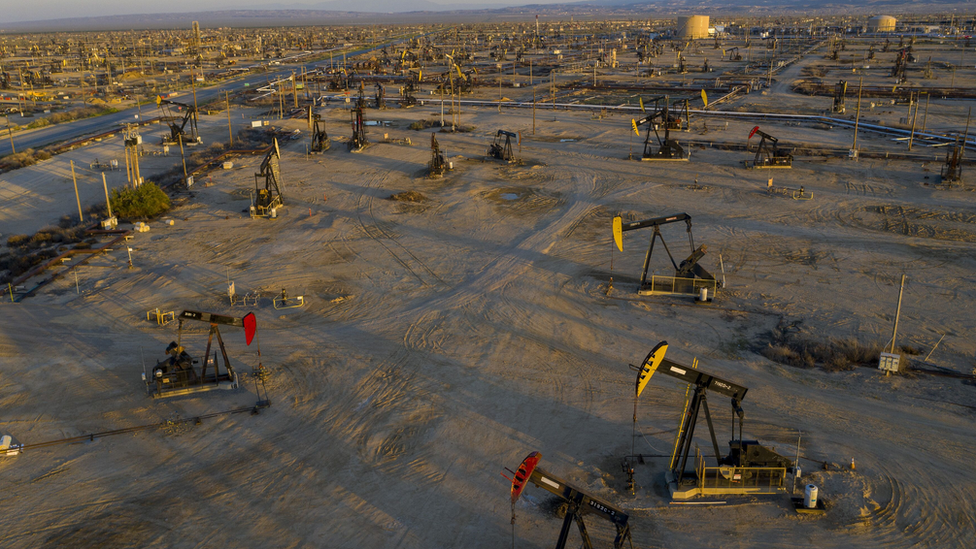
The oil industry has ground to a halt as demand has slumped
What if CO2 was cut like this each year?
To keep the world on track to stay under 1.5C this century, the world needs similar cuts for the foreseeable future to keep this target in view.
"If Covid-19 leads to a drop in emissions of around 5% in 2020, then that is the sort of reduction we need every year until net-zero emissions are reached around 2050," said Glen Peters, also from Cicero.
"Such emissions reductions will not happen via lockdowns and restrictions, but by climate policies that lead to the deployment of clean technologies and reductions in demand for energy."
Energy experts believe there will be a bounce back next year, but that, long term, the world will move to greener fuels.
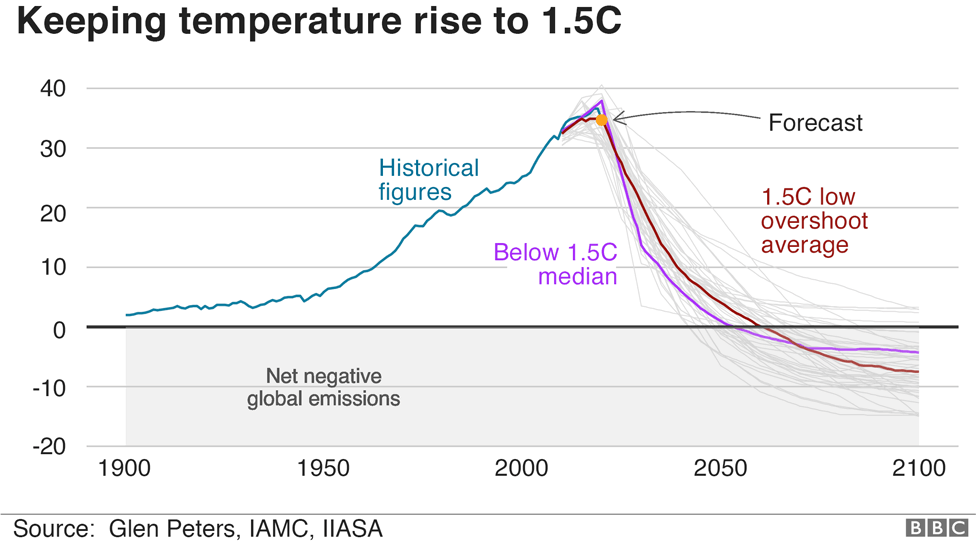

But it may not be enough to keep temperatures down to safer levels.
"That downward slope will accelerate over time beyond peak fossil energy," said Erik Holm Reiso, from Rystad Energy.
"That doesn't chime with 1.5C, but maybe 1.8-1.9C degrees could be within reach and this situation right now could help achieve that, I think."
Lessons learnt?
Many climate researchers are optimistic that this deadly pandemic has taught governments some critical lessons that they can apply to the problem of rising temperatures.
The big challenge is to ensure the recovery has a green focus.
According to Prof Gail Whiteman from Lancaster University, UK, it was almost impossible to believe that governments around the world, when faced with a health emergency, would put humanity ahead of the economy. But they did.

A SIMPLE GUIDE: How do I protect myself?
AVOIDING CONTACT: The rules on self-isolation and exercise
HOPE AND LOSS: Your coronavirus stories
LOOK-UP TOOL: Check cases in your area
TESTING: Can I get tested for coronavirus?

"We can recover from an existential, complex threat and emerge much stronger and more resilient," she says.
"Which strengthens the idea that we can do things differently on climate, that we can tackle this one.
"I think it gives us huge energy."
Follow Matt on Twitter., external

